In this issue:
Basil Downy Mildew
Seedcorn Maggot
Asparagus Beetle
Flea Beetles in Brassicas
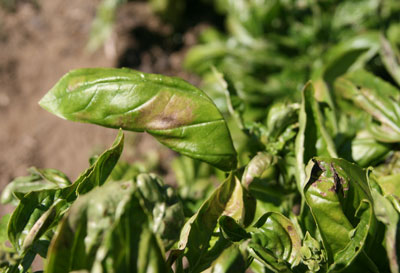 |
| Basil downy mildew |
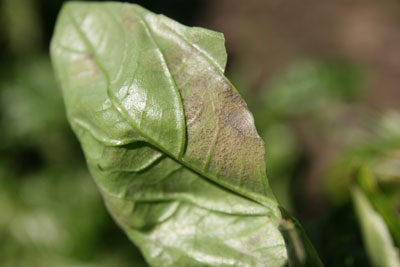 |
| Basil downy mildew on the underside of a basil leaf |
BASIL DOWNY MILDEW
It is very early in the season to be mentioning this problem, but once again long distance marketing from large corporations has created an issue. Seedlings that are already infected with basil downy mildew have been sold over the internet, and so it is likely that gardeners all over have introduced the pathogen to their fields. The extent of the spread will depend on weather conditions. Be on the lookout.
This is a pretty new problem, and it has been widespread the past few growing seasons. Downy mildew of basil was first reported in Uganda back in 1930. Recently it has been getting lots of attention as it spreads, first to Italy in 2004, France in 2005, United States (Florida) in 2007 and by 2009 New England.
The first symptom is a pale yellowing of the upper surface of the leaves, quite similar to sunscald. Later, vein-bounded patches of dark spore production can be seen on the lower surface. This develops into a gray, fuzzy growth typical of downy mildews of other crops. At first you may be able to convince yourself that some soil has been splashed onto the underside of the leaf, but soon the plants will be going down and it will be clear that it is not a problem that can be washed away.
The disease may be seed borne, but that is probably a very rare event. The spread in most likely due to the wind blown spores. In the damp conditions of the early and mid summer they could move far and wide. There is also some belief that seedlings already infected and moved across country for sale play a role. And this year it again seems like some outfits are selling plants already infected.
The infected leaves are safe to eat, and I have a report from a grower that mildly infected leaves still made a fine tasting pesto. Some types of basil are less or not susceptible at all. For example, my Thai basil is fine. I have heard from a grower that the lemon basil is not susceptible, and that the purple basil seems a bit less susceptible. The common sweet basil is the most susceptible. If you have this problem, and you grow more than one type of basil, please keep records and let me know if you see any resistance so we can make some recommendations for next year. I have heard that Dolly is very susceptible and went down even though the other sweet basil varieties in the field were fine. The folks at Johnnys and lots of others are working hard to get resistant varieties and have some in their catalogs noting resistance. For now, if you see downy mildew on the variety you are growing, make pesto fast.
There are relatively few fungicides labeled for herbs. Also, I have not seen reports of efficacy of any. Some copper fungicides are labeled. Other OMRI listed products that are labeled for herbs include Actinovate AG, Trilogy, and OxiDate. But, again, I do not have any evidence that they are effective. If you try any of these, leave some plants untreated so we can get some information.
For now, anything that will make the leaves dry quickly will help, e.g., weed control, good spacing, venting tunnels, watering in the morning instead of the evening, etc. I make new plantings every 3-4 weeks in hopes that if the spores come in and infect one planting I can destroy it so it does not release spores, and I have another planting waiting in the wings.
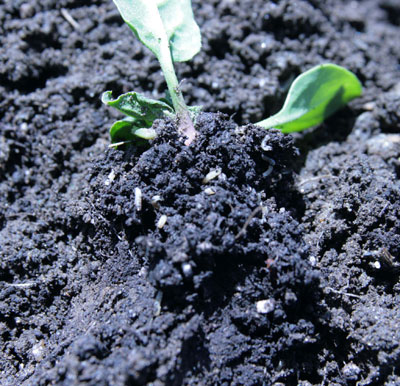 |
| Spinach seedling with tiny white maggots feeding on the roots |
SEEDCORN MAGGOTS Hylemya platura
The risk of this early spring problem is long gone, but if you watched some of your seedlings yellow and wilt, and saw maggots chewing up the roots, then you should read this and do better next year. Seedcorn maggot larvae feed on seeds and young seedlings of many crops (corn, beans, beets, peas, spinach, onions, cole crops, etc.). The first symptoms are usually poor germination (or failure of seedlings to emerge), or wilting transplants that have lost their roots to feeding. Symptoms can be difficult to distinguish from other problems, such as damping off due to Pythium or other soilborne fungi, or wireworm feeding. Also, symptoms are similar to damage caused by the cabbage or onion maggot, which have very similar behavior.
If seedcorn maggots are the culprit, maggots can usually be found in the soil around and inside seedlings and seeds. The seedcorn maggot is yellow-white, 1/4 inch long, legless, with a wedge-shaped head. The adults look like small houseflies. Seedcorn maggots overwinter in the soil as pupae. In early spring, the adults emerge and lay eggs where they smell organic matter, such as compost or manure you added to a field, decaying seeds (maybe even soy meal you added as a fertilizer), etc. The eggs hatch within 2-4 days at soil temperatures of 50F. Research has shown that peak emergence of the first three generations occur when 200, 600 and 1000 degree days have accumulated. Degree days are calculated on a daily basis by using the formula: (Max temp – Min temp)/2 – 39F. The University of Massachusetts Vegetable Notes recently had a great discussion of growing degree days, and these maggots. See https://ag.umass.edu/sites/ag.umass.edu/files/newsletters/may_7_2015_vegetable_notes.pdf
The first generation usually causes the most damage. That is gone now. The maggots have done their damage and I no longer find them. Adults prefer to lay eggs in wet soil that is rich in organic matter. Manure or unfinished compost are very attractive to the flies, and actually may even contain pupa from the previous fall. Seeds that germinate slowly are more vulnerable to attack. Crops that are planted in wet, and or cool soil, may be especially susceptible to damage. Two years ago my earliest planted spinach seedlings wilted within a week of transplanting. When I pulled one up for examination I saw that it was swarming with maggots. This year I covered the early planting with row cover.
Management strategies:
By the time you see damage, it is too late to control the problem using either cultural or chemical methods. Prevention is the key.
• Avoid seeding fields (especially wet fields) too early. Seeds germinate more quickly and are less vulnerable in warmer and drier soils.
• Disk and incorporate organic matter (such as a cover crop) at least 4 weeks before seeding to give it time to break down and make it less attractive to the flies
• Avoid applying manure or unfinished compost in late fall or early spring to heavy soils that you might want to plant early. Lighter, well-drained, sandy soils are less likely to have problems (because they warm up and dry out faster than others).
• Rowcovers will work if you get them on at planting time – but only if the maggot flies are coming from elsewhere. Damage can occur if the flies have overwintered in the soil (or manure you apply), and thus end up underneath the rowcovers.
* There is some evidence that beneficial nematodes will help, as is there for a soil drench with Entrust. I don’t believe either will be the silver bullet if you already see damage.
• If you need to replant, wait at least 5 days if maggots that you find are a quarter inch long; if they are smaller than that, wait at least 10 days to make sure they have pupated and will not damage the new seeds.
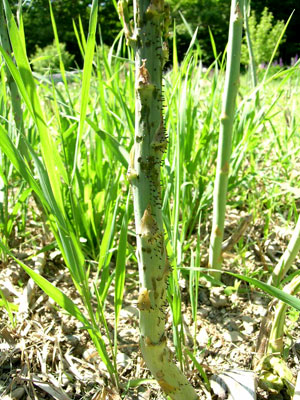 |
| Asparagus beetle eggs |
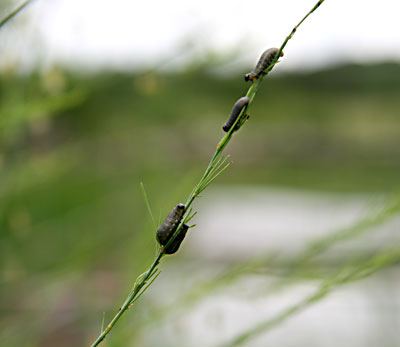 |
| Asparagus beetle larvae |
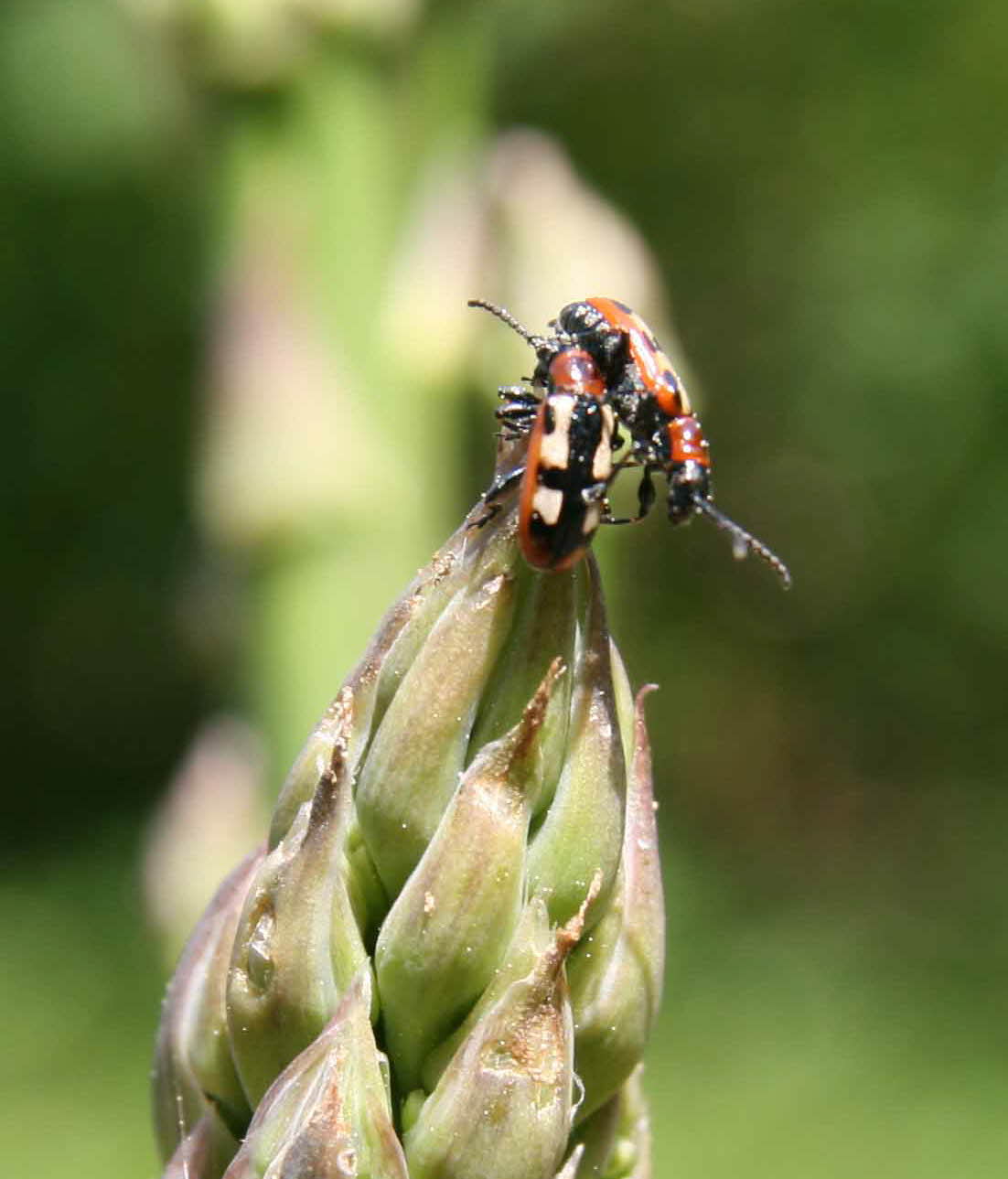 |
| Asparagus beetles |
Top
ASPARAGUS BEETLE, COMMON AND SPOTTED
Frost first
One of the very first questions I received when I began working for MOFGA many, many years ago turned into an argument. Not a good start for my tenure, but I stuck it out. The guy who called would not believe me that asparagus is frost sensitive. His spears had turned dark, wrinkled and water-soaked. I don’t know if I ever convinced him that the problem was they were frosted. Perhaps he is reading this.
Asparagus, despite its status as a primo early season vegetable, is sensitive to frost, ranking alongside cucumber, snap beans, eggplant and tomatoes in the ‘most susceptible’ category. We were 28 degrees a few weeks ago, and although now we are likely past any risk of frost, some of you may be wondering what happened to those spears that poked up on the wrong morning.
When frosted, spears appear slightly darker green, water-soaked and break off easily. Thawed spears become mushy. Soft-rotting bacteria can enter the damaged tissue. New spears take several more days to emerge, but will. Temperatures below 33 degrees Fahrenheit may damage the spears.
The beetles
I have seen both kinds of asparagus beetles here. Usually the spotted asparagus beetle becomes active somewhat later in the spring, and in my experience is less common (I guess with the names that is not a surprise). These two beetles are closely related and have similar life cycles, but it is the common asparagus beetle that is most damaging to the spears.
Common asparagus beetle (Crioceris asparigi) is blue-black, shiny, smooth and about 6 to 9 mm (1/4 inch) long, with three large yellow, squarish spots with red margins along each wing cover. Eggs are black, laid standing on end in rows along the spears, and hatch in 3-8 days. [Remember, you can see pictures on the MOFGA web version of the Pest Report]. Larvae are wrinkled, plump, hump-backed, and dull gray with black head and legs. Some people call them “worms”. They grow up to 1/3 inch. These larvae feed in spears and in ferns. The larvae do the most damage, and eggs and larval damage makes spears unmarketable. Larval feeding can cause severe defoliation and weaken the stand. When full grown, larvae drop to the soil and pupate underground. New adults emerge in July, feed in ferns, and by September are looking for overwintering sites. Both species spend the winter as adult beetles either in field borders or within the asparagus field. Sheltered sites such as under bark or in the stems of old plants are preferred. Some burrow into the soil.
Spotted asparagus beetle (Crioceris duodecimpunctata) is reddish orange or tan, with six black spots on each wing cover (hence its other name, 12-spotted asparagus beetle). Eggs are greenish, glued singly on their sides to leaves. Eggs are laid on fronds, not on spears. Larvae are similar to those described above, but are orange colored, and feed almost entirely inside the berries so they affect seed production but do not hurt the plants.
Cultural controls: During harvest, you can greatly reduce the population by harvesting ALL of the ready spears every harvest. Do not allow any spears to develop into fronds until you are all done harvesting for the season. This reduces the number of stems where eggs will survive, and larvae can feed and grow up into the summer-generation beetles. In the fall remove all of the crop residue and other refuse nearby that provides shelter for adults over winter. Maintaining a clean environment in the fall will force beetles to seek shelter outside the field or burrow in the soil, where many predators reside.
Biocontrol: The most important natural enemy of Common asparagus beetle is a tiny parasitic wasp (Tetrastichus asparagi) that attacks the egg stage. Wasps kill eggs by feeding on them (sucking them dry), and also lay their own eggs inside the beetle eggs. The immature wasps grow inside the beetle larvae, killing them when they pupate. Studies have found >50% of eggs killed by feeding and half of the surviving larvae parasitized. Providing a nearby nectar source such as umbelliferous flowers may enhance wasp populations.
Monitoring and chemical control: Scout fields regularly. You may want to treat spears if >10% of the plants are infested with beetles or 2% have eggs or damage. The daily harvest makes treatment difficult because few want to spray anything close to harvest time. Treating infested fronds is important. Organic options include Entrust. Surround WP may work as a repellent.
Thanks to: Ruth Hazzard (U. Mass Vegetable Notes & The New England Vegetable Management Guide), and Brian Caldwell, Cornell University
Top
FLEA BEETLES IN BRASSICAS
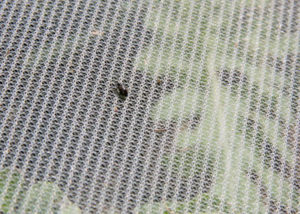  |
| Crucifer flea beetle damage |
Flea beetles are busy feeding in spring plantings of brassica crops. Numbers are likely to rise in coming weeks as beetles move out of field borders where they spent the winter. Crucifer and striped flea beetles feed on Brassica crops as well as weeds that are in the same family, such as yellow rocket or wild mustard. [It is a different species of flea beetles that feeds on the tomato family of crops. This is important information when planning rotations of potatoes or tomatoes with Brassica crops or cover crops].
The crucifer flea beetle (Phyllotreta cruciferae) is uniformly black and shiny, about 2 mm in length, while the striped flea beetle (Phyllotreta striolata) has two yellow stripes on its back. Flea beetle adults feed on leaves and stems, resulting in numerous small holes, or ‘shot-holes’. Eggs are laid in the soil starting in late May, and beetle larvae feed on roots. The non-waxy greens (arugula, bok choi, tatsoi, mustard, Chinese cabbage, komatsuna) are preferred to the waxy cabbage, kale and collard types of brassicas. In brassica greens, beetles feed on the whole surface of the leaf, and will continue feeding from the seedling stage until harvest. Waxy crops are most susceptible at the cotyledon and seedling stage and feeding is more limited to leaf margins on older plants. Some crops simply out grow the beetle pressure and the damage can be tolerated. No damage can be tolerated in crops such as arugula.
To reduce and delay flea beetle invasion of spring crops, move them as far away as possible from the fields that were used for Brassica crops last fall. Beetles overwinter in field borders near last year’s crop. Planting the same crop close by to where it was last year ensures a high population in the spring. The same could be true if you have fields full of mustard weeds.
One of the best ways to protect Brassica crops from flea beetles is to place a floating row cover over the bed or row. It is critical to get the row cover in place and seal the edges immediately after seeding or transplanting, because Brassica seeds germinate quickly and beetles rapidly find the cotyledons. Flea beetles can fit through extremely tiny cracks. Edges of the cover must be sealed on all sides using soil, plastic bags filled with soil, or some other method.
Spinosad (Entrust is organic formulation) is proving to be effective in suppressing flea beetles and reducing damage. Pyrethrin (Pyganic EC 5) showed poor to moderate efficacy in trials, and has a short residual period. Yet some growers have reported a good knockdown with this product. You can spray right through the floating row covers and knock down any flea beetles that may have gotten inside.

